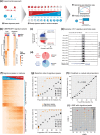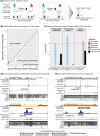Alpha TC1 and Beta-TC-6 genomic profiling uncovers both shared and distinct transcriptional regulatory features with their primary islet counterparts
- PMID: 28931935
- PMCID: PMC5607285
- DOI: 10.1038/s41598-017-12335-1
Alpha TC1 and Beta-TC-6 genomic profiling uncovers both shared and distinct transcriptional regulatory features with their primary islet counterparts
Abstract
Alpha TC1 (αTC1) and Beta-TC-6 (βTC6) mouse islet cell lines are cellular models of islet (dys)function and type 2 diabetes (T2D). However, genomic characteristics of these cells, and their similarities to primary islet alpha and beta cells, are undefined. Here, we report the epigenomic (ATAC-seq) and transcriptomic (RNA-seq) landscapes of αTC1 and βTC6 cells. Each cell type exhibits hallmarks of its primary islet cell counterpart including cell-specific expression of beta (e.g., Pdx1) and alpha (e.g., Arx) cell transcription factors (TFs), and enrichment of binding motifs for these TFs in αTC1/βTC6 cis-regulatory elements. αTC1/βTC6 transcriptomes overlap significantly with the transcriptomes of primary mouse/human alpha and beta cells. Our data further indicate that ATAC-seq detects cell-specific regulatory elements for cell types comprising ≥ 20% of a mixed cell population. We identified αTC1/βTC6 cis-regulatory elements orthologous to those containing type 2 diabetes (T2D)-associated SNPs in human islets for 33 loci, suggesting these cells' utility to dissect T2D molecular genetics in these regions. Together, these maps provide important insights into the conserved regulatory architecture between αTC1/βTC6 and primary islet cells that can be leveraged in functional (epi)genomic approaches to dissect the genetic and molecular factors controlling islet cell identity and function.
Conflict of interest statement
The authors declare that they have no competing interests.
Figures




Similar articles
-
Single-cell ATAC-Seq in human pancreatic islets and deep learning upscaling of rare cells reveals cell-specific type 2 diabetes regulatory signatures.Mol Metab. 2020 Feb;32:109-121. doi: 10.1016/j.molmet.2019.12.006. Epub 2019 Dec 20. Mol Metab. 2020. PMID: 32029221 Free PMC article.
-
ATAC-seq reveals alterations in open chromatin in pancreatic islets from subjects with type 2 diabetes.Sci Rep. 2019 May 23;9(1):7785. doi: 10.1038/s41598-019-44076-8. Sci Rep. 2019. PMID: 31123324 Free PMC article.
-
Integration of ATAC-seq and RNA-seq identifies human alpha cell and beta cell signature genes.Mol Metab. 2016 Jan 11;5(3):233-244. doi: 10.1016/j.molmet.2016.01.002. eCollection 2016 Mar. Mol Metab. 2016. PMID: 26977395 Free PMC article.
-
Genomics of Islet (Dys)function and Type 2 Diabetes.Trends Genet. 2017 Apr;33(4):244-255. doi: 10.1016/j.tig.2017.01.010. Epub 2017 Feb 27. Trends Genet. 2017. PMID: 28245910 Free PMC article. Review.
-
(Epi)genomic heterogeneity of pancreatic islet function and failure in type 2 diabetes.Mol Metab. 2019 Sep;27S(Suppl):S15-S24. doi: 10.1016/j.molmet.2019.06.002. Mol Metab. 2019. PMID: 31500827 Free PMC article. Review.
Cited by
-
mTORC1 and mTORC2 Complexes Regulate the Untargeted Metabolomics and Amino Acid Metabolites Profile through Mitochondrial Bioenergetic Functions in Pancreatic Beta Cells.Nutrients. 2022 Jul 22;14(15):3022. doi: 10.3390/nu14153022. Nutrients. 2022. PMID: 35893876 Free PMC article.
-
Stathmin-2 Mediates Glucagon Secretion From Pancreatic α-Cells.Front Endocrinol (Lausanne). 2020 Feb 4;11:29. doi: 10.3389/fendo.2020.00029. eCollection 2020. Front Endocrinol (Lausanne). 2020. PMID: 32117057 Free PMC article.
-
Arginine-vasopressin mediates counter-regulatory glucagon release and is diminished in type 1 diabetes.Elife. 2021 Nov 17;10:e72919. doi: 10.7554/eLife.72919. Elife. 2021. PMID: 34787082 Free PMC article.
-
Multi-omic human pancreatic islet endoplasmic reticulum and cytokine stress response mapping provides type 2 diabetes genetic insights.Cell Metab. 2024 Nov 5;36(11):2468-2488.e7. doi: 10.1016/j.cmet.2024.09.006. Epub 2024 Oct 8. Cell Metab. 2024. PMID: 39383866
-
Models in Pancreatic Neuroendocrine Neoplasms: Current Perspectives and Future Directions.Cancers (Basel). 2023 Jul 25;15(15):3756. doi: 10.3390/cancers15153756. Cancers (Basel). 2023. PMID: 37568572 Free PMC article. Review.
References
Publication types
MeSH terms
Grants and funding
LinkOut - more resources
Full Text Sources
Other Literature Sources
Medical
Molecular Biology Databases

